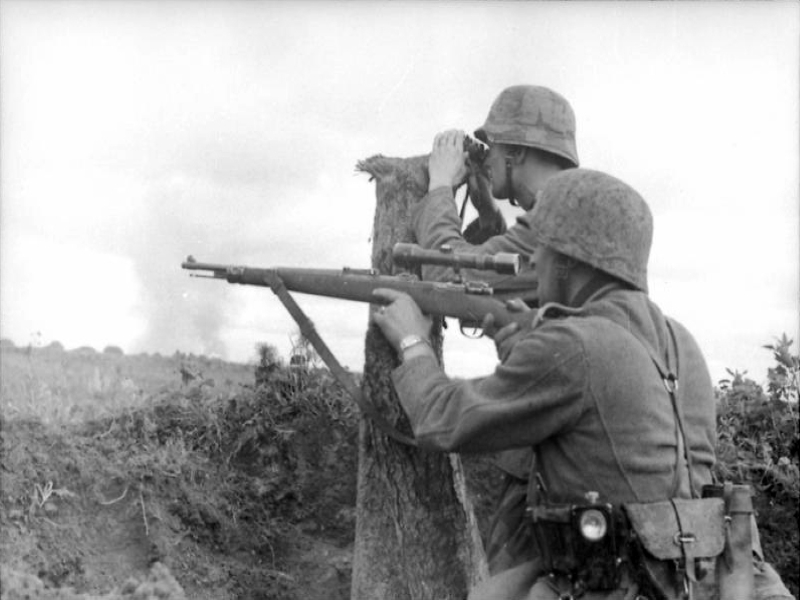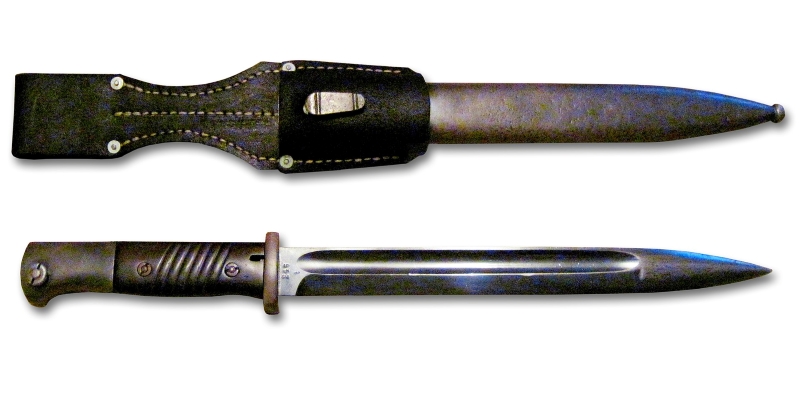Today we’re going to take a peek at Germany’s main battle rifle, the venerable Mauser — their mainstay through two world wars.
I can still remember the Mauser K98k that my step-grandfather sometimes showed me. He landed at Normandy several days after D-Day and had acquired the rifle, which had been captured from the Germans. The stock was a dark color and the metal, to the best of my memory, was mostly unfinished. At least the bolt was unfinished. He also had a bayonet that matched the rifle.
As a teenager, I looked upon that rifle with complete awe. It was from a monumental event in history—the most profound and important event in the 20th century. He told me that when Germans were about to be captured, they would often remove the bolt from their rifle and throw it as far as they could so that the allies could not use the rifles. He also related stories about how Germans were using wooden bullets because metals were in such short supply.
When he passed away, another family member snatched up that rifle and I never saw it again. I sometimes wonder where it is today. That was one special firearm, I’ll tell you, given its provenance.
Ever since then, I’ve always enjoyed seeing Mausers and learning about them. Let’s take a look at the history of the Mauser and some little-known facts.

1. Civilian Use
Mausers were not only used by the military. There was a strong following in the civilian sector as well. Many safari rifles used in Africa are modified Mausers, often with the original caliber being altered. This practice began in the late 19th century and into the 20th century. Both large and small game have been hunted with these rifles. Even today, the Mauser design is influential in rifle design, and still popular with hunters.
2. Lions & Tigers, Oh My!
The Mauser’s controlled-round feeding has made it popular with both military and civilian users. When hunting dangerous game, it is a very desirable feature. As soon as the round leaves the magazine, it is picked up by the extractor, which increases reliability. The three-lug design of the bolt also makes it very safe and unlikely to fail.

3. The Mauser is a collector’s item.
These days, surplus military Mausers are bringing premium prices and are highly sought after by collectors. A number of years ago, you could walk into a gun shop and find dozens of them on the racks for just above $100. These days, you can’t get close to one for that price.

4. German Adoption
The Gewehr (Rifle) 98 (G98, Gew 98, M98), designed by Paul Mauser, was the main German service rifle from 1998 until 1935. It fires a 7.92x57mm round and is loaded via five-round stripper clips into an internal magazine. It weighs nine pounds and was 49.2 inches long. The barrel length is 29.1 inches long.



5. Mauser Projectiles
The M98 Mauser used a 9.72×57 caliber bullet that weighed 227 grains and was a round-nosed FMJ profile. Velocity was 2,000 feet per second. Later on, this was changed to a 153-grain bullet with a spitzer profile. The velocity of this new round was 2,700 feet per second.
6. Baptism Of Fire
The first combat use of the Gewehr 98 was during the Boxer rebellion, which lasted from 1898 until 1901.

7. Less Than Perfect
Interestingly, the minimum sight setting for the G98’s sights was 400 meters. This was often too far for the distances between trenches, which often tended to be well under 400 meters. The long length of this rifle also made it ungainly and awkward for close-quarter fighting, such as inside trenches.

8. Big Numbers
When WWI began, Germany had nearly 2.3 million Gewehr 98 rifles. During the war, they managed to produced another seven million G98s. Production of the G98 was labor intensive and required a great deal of machine work.

9. Sniper System
The Scharfschützen-Gewehr 98 (sniper rifle 98) was adopted in 1915 and featured a 4-x scope. The scope had to be mounted offset to the left to allow stripper clips to still be used for feeding the rifle. So that it could still be operated, the bolt handle had to be turned downward and a recess put into the stock to accommodate the bolt handle. Snipers made life in the trenches very hazardous, with soldiers on both sides unable to stick their heads above the trenches for fear of being shot.

10. Non-Standard Sniper Systems
Throughout WWI, many sniper rifles were made using civilian optics due to military wartime shortages. Although the Germans attempted to standardize their sniper systems, it was not possible, hence the reliance on civilian scopes.
11. Conversions & Updates
Some G98s were used during WWII, but many were converted to the K98k configuration during that time period. Germany had millions of these rifles, and they weren’t about to let them go to waste.
12. The Karabiner 98k


The Kar 98K (Karabiner 98K, K98k) Mauser began service in 1935, sporting a barrel length of 23.62 inches and an overall length of 43.7 inches. The weight is around 8.5 pounds. The caliber is 7.92x57mm. This rifle became the main rifle of the German military shortly before WWII, up to the end of WWII. Instead of the straight bolt handle of the Gewehr 98, the K98k featured a turned-down bolt handle, which made operation easier. Additionally, it facilitated mounting optics on the K98.

13. Where’s the rest of the rod?
Each K98k was fitted with a section of cleaning rod that was fitted through the bayonet stud. Three of these rods would be joined together to form one full-length cleaning rod. Many current owners today are left scratching their heads, wondering why their cleaning rod is so short and not long enough to fit down the barrel of their 98k. Well, it takes three rifles to make one rod!
14. Mauser Stock Options
Laminated stocks were used in K98k rifles from 1937 onward, with the plywood laminate proving more durable than one-piece stocks. As an added bonus, laminated stocks were cheaper to manufacture and did not require a period to mature the wood. Walnut, Elm, and Beech were mostly used for the laminated stocks. A steel butt plate adorned all buttstocks.

15. Spreading The Wealth
Mausers were not only used by Germany but by a wide host of other countries as well. Spain, Chili, and Sweden produced their own versions of the Mauser 98. Most of Germany’s allies were equipped with Mauser rifles during WWII.


